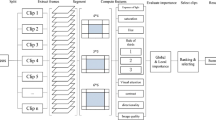Abstract
The main goal of the proposed method is to select from a video the most “significant” frames in order to broadcast, without apparent loss of content by decreasing the potential distortion criterion. Initially, the video is divided into shots and the number of synopsis frames per shot is computed based on a criterion that takes into account the visual content variation. Next, the most “significant” frames are sequentially selected, so that the visual content distortion between the initial video and the synoptic video is minimized. Experimental results and comparisons with other methods on several real-life and animation video sequences illustrate the high performance of the proposed scheme.
Access this chapter
Tax calculation will be finalised at checkout
Purchases are for personal use only
Preview
Unable to display preview. Download preview PDF.
Similar content being viewed by others
References
Panagiotakis, C., Doulamis, A., Tziritas, G.: Equivalent key frames selection based on iso-content principles. IEEE Transactions on Circuits and Systems for Video Technology 19, 447–451 (2009)
Hanjalic, A., Zhang, H.: An integrated scheme for automated video abstraction based onunsupervised cluster-validity analysis. IEEE Trans. on Circuits and Systems for Video Tech. 9, 1280–1289 (1999)
Girgensohn, A., Boreczky, J.S.: Time-constrained keyframe selection technique. Multimedia Tools and Applications 11, 347–358 (2000)
Panagiotakis, C., Doulamis, A., Tziritas, G.: Equivalent key frames selection based on iso-content distance and iso-distortion principles. In: IEEE International Workshop on Image Analysis for Multimedia Interactive Services (2007)
Hammoud, R., Mohr, R.: A probabilistic framework of selecting effective key frames for video browsing and indexing. In: International Workshop on Real-Time Image Sequence Analysis (RISA 2000), pp. 79–88 (2000)
Manjunath, B., Ohm, J., Vasudevan, V., Yamada, A.: Color and texture descriptors. IEEE Trans. on Circuits and Systems for Video Tech. 11, 703–715 (2001)
Li, Z., Schuster, G., Katsaggelos, A.: Minmax optimal video summarization. IEEE Trans. Circuits Syst. Video Techn. 15, 1245–1256 (2005)
Ngo, C.W., Ma, Y.F., Zhang, H.J.: Video summarization and scene detection by graph modeling. IEEE Trans. Circuits Syst. Video Techn. 15, 296–305 (2005)
Kasutani, E., Yamada, A.: The mpeg-7 color layout descriptor: a compact image feature description for high-speed image/video segment retrieval, pp. 674–677 (2001)
Pele, O., Werman, M.: The quadratic-chi histogram distance family. In: Daniilidis, K., Maragos, P., Paragios, N. (eds.) ECCV 2010, Part II. LNCS, vol. 6312, pp. 749–762. Springer, Heidelberg (2010)
Author information
Authors and Affiliations
Editor information
Editors and Affiliations
Rights and permissions
Copyright information
© 2013 Springer-Verlag Berlin Heidelberg
About this paper
Cite this paper
Panagiotakis, C., Ovsepian, N., Michael, E. (2013). Video Synopsis Based on a Sequential Distortion Minimization Method. In: Wilson, R., Hancock, E., Bors, A., Smith, W. (eds) Computer Analysis of Images and Patterns. CAIP 2013. Lecture Notes in Computer Science, vol 8047. Springer, Berlin, Heidelberg. https://doi.org/10.1007/978-3-642-40261-6_11
Download citation
DOI: https://doi.org/10.1007/978-3-642-40261-6_11
Publisher Name: Springer, Berlin, Heidelberg
Print ISBN: 978-3-642-40260-9
Online ISBN: 978-3-642-40261-6
eBook Packages: Computer ScienceComputer Science (R0)




